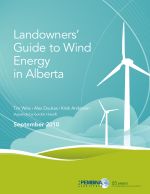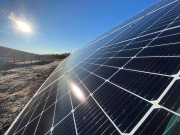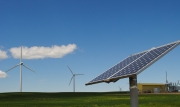Wind energy has huge potential in Alberta. It can help clean up what is currently Canada's most polluting electricity system, and it can bring long-term economic development opportunities to new parts of the province, but wind energy does have impacts that should be managed.
This is why we at the Pembina Institute have produced the Landowners' Guide to Wind Energy in Alberta to help landowners learn about and get involved with wind energy.
The guide comes at a time when investors are busy investigating wind projects in Alberta. These projects could result in 7,400 megawatts (MW) of new electricity generation in the province - that would be close to 20 per cent of the province's electricity supply by the time it's built. That's a big opportunity for increase from the 656 MW of wind energy installed in Alberta.
 Last year, I co-authored a study called Greening the Grid, which illustrated how Alberta can make major transitions to renewable electricity in the next 20 years - and create new economic opportunities while doing so.
Last year, I co-authored a study called Greening the Grid, which illustrated how Alberta can make major transitions to renewable electricity in the next 20 years - and create new economic opportunities while doing so.
Landowners and municipalities have opportunities to lease their land to wind farms and earn royalties, providing income plus construction and maintenance jobs. And landowners can install their own farm-scale wind turbines, thanks to a new micro-generation regulation introduced in Alberta in 2009.
Of course, there are plenty of questions to ask before jumping into the wind industry. Our new guide helps landowners, municipal governments and agricultural organizations navigate the wind industry. How can you get involved? What are the potential benefits and risks of having wind power developed on or near your land? What areas of Alberta are suitable for wind generation? What questions should you ask? All of these questions, and more, are answered in the Landowners' Guide to Wind Energy in Alberta.
From micro-generation to royalties
Gordon Howell, an Alberta expert on small-scale renewable energy, was invited to write a special 20-page, step-by-step guide to hooking up a small wind energy project to the grid. He covers all the details Alberta's new micro-generation regulation, which streamlines the process for small operators.

Most landowners will probably not build their own wind farm, but many will get involved by leasing land to small and large wind developers. Landowners receive revenue for these leases, and this guide helps landowners understand how royalties work, how these arrangements are structured and what types of contracts are negotiated. The guide also helps landowners understand the development process from early resource monitoring, to project construction and operation.
The guide is also intended to answer questions landowners have about wind energy in general, whether about birds, bats or health effects.
Birds and bats
For example, bird and bat fatalities can be reduced significantly by proper site selection and operating techniques. While it is important to take these impacts seriously, it is also important to understand that the overall environmental effects are lower for wind energy than for coal, nuclear, natural gas and even large hydro. As a source of energy, wind causes among the least harm to wildlife - it is second only to solar power.

Any bird loss is bad, of course, but to keep it in perspective, pesticides, vehicles, cats, high-tension wires, buildings and windows are many hundreds of times worse than wind turbines. There are certainly things wind developers can do to make sure they are minimizing their impacts. Alberta developers have by and large not repeated the mistakes made in early, poorly-located projects.
Get the guide
 The new wind energy guide will help landowners, municipal governments, agricultural organizations and even wind or utility companies learn about and share information about the growing wind industry in Alberta.
The new wind energy guide will help landowners, municipal governments, agricultural organizations and even wind or utility companies learn about and share information about the growing wind industry in Alberta.
The guide is free for individuals in PDF format.
As coal goes, wind energy is on the rise
Other provinces are seizing this opportunity, not only to build renewable power, but to create new jobs and in some cases shut down polluting coal power plants. Ontario, which recently surpassed Alberta in wind generation, has also reduced its coal-fired electricity production by 70 per cent in just seven years, and is expected to shut it all down by 2013. Elsewhere in Canada, Nova Scotia is aiming for 40 per cent renewable electricity in the next ten years, a target that will cut their coal use in half. Alberta has big opportunities to use green energy such as wind power to reduce its reliance on coal too.









